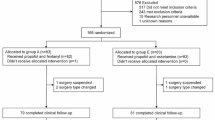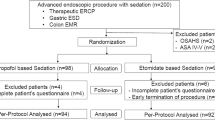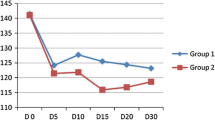Abstract
Background and aims
In this study, we compared duration for reaching desired Ramsay Sedation Score (RSS) and postoperative recovery according to Modified Aldrete Score (MAS) of propofol and propofol-ketamine combination in a group of colonoscopy patients. Rates of cardiovascular, respiratory, laryngospasm, visual and nausea/vomiting complications were also compared as secondary outcomes.
Methods
This is a double-blinded prospective randomized controlled trial. 95 patients were included and blocked randomized to either propofol (GroupP, n: 47) or propofol-ketamine (GroupPK, n: 48). GroupP patients received 0.5 mg/kg propofol and GroupPK received 0.5 mg/kg ketamine-propofol. Subjects were monitorized noninvasively preoperatively and every 5 min during procedure. RSS was recorded for every minute before starting procedure and for every 5 min during procedure. Recovery after colonoscopy was evaluated according to MAS. Same observer checked for MAS just after procedure in postoperative 1 min and for every 3 min during follow-up. Postoperative respiratory depression was defined as rate <10/min, hypercapnia/hypercarbia—arterial CO2 tension >50 mmHg or SO2 <90 while hypotension was defined as a decrease of 20 % in mean blood pressure compared to initial values.
Results
GroupPK patients needed shorter duration for achieving RSS ≥ 4 (p: 0.038) but longer duration for achieving MAS ≥ 9 (p: 0.005). GroupP’s intraoperative blood pressures and heart rates were significantly lower compared to initial values. We observed that respiratory depression (19.1 vs 0 %, p: 0.001), hypotension (29.8 vs 10.4 %, p: 0.018), and nausea/vomiting (17 vs 4.2 %, p: 0.041) were significantly more common in GroupP.
Conclusion
Propofol-ketamine combination is an advantageous choice in means of achieving sedation in a shorter period of time, a better hemodynamic stability, less nausea and vomiting and respiratory complication rates. Yet it seems that this choice might be related with longer recovery duration.
Similar content being viewed by others
References
Morgan, G. Edward, Maged S, Murray MJ (2008) Lange Clinical Anesthesiology. Lange Medical Books/McGraw Hill Medical Pub, New York, pp 179–203
Arora S (2008) Combining Ketamine and propofol (“Ketofol”) for emergency department procedural sedation and analgesia: a review. WestJEM 9(1):20–23
Badrinath S, Avramov MN, Shadrick M et al (2000) The use of a ketamine-propofol combination during monitored anesthesia care. Anesth Analg 90(4):858–862
Tanaka M, Sato M, Saito A et al (2000) Reevaluation of rectal ketamine premedication in children: comparison with rectal midazolam. Anesthesiology 93(5):1217–1224
Erdogan MA, Begec Z, Aydogan MS (2013) Comparison of effects of propofol and ketamine-propofol mixture (ketofol) on laryngeal mask airway insertion conditions and hemodynamics in elderly patients: a randomized, prospective, double-blind trial. J Anesth. 27(1):12–17
Ozgul U, Begec Z, Karahan K et al (2013) Comparison of propofol and ketamine-propofol mixture (Ketofol) on laryngeal tube-suction ii conditions and hemodynamics: a randomized, prospective, double-blind trial. Curr Ther Res Clin Exp. 75:39–43
McQuaid KR, Laine L (2008) A systematic review and meta-analysis of randomized, controlled trials of moderate sedation for routine endoscopic procedures. Gastrointest Endosc 67(6):910–923
Cok OY, Eker HE, Izmirli H et al (2009) Sedation during endoscopic retrograde cholangiopancreatography: The comparison of propofol - ketamine mixture infusion with bolus administrations. J Anesth 17(1):49–54
Chen WX, Lin HJ, Zhang WF et al (2005) Sedation and safety of propofol for therapeutic endoscopic retrograde cholangiopancreatography. Hepatobiliary Pancreat Dis Int 4(3):437–440
Kongkam P, Rerknimitr R, Punyathavorn S et al (2008) Propofol infusion versus intermittent meperidine and midazolam injection for conscious sedation in ERCP. J Gastrointestin Liver Dis 17(3):291–297
Varadarajulu S, Eloubeidi MA, Tamhane A et al (2007) Prospective randomized trial evaluating ketamine for advanced endoscopic procedures in difficult to sedate patients. Aliment Pharmacol Ther 25(8):987–997
Kayhan GE, Toprak HI, Aslan A et al (2013) Anaesthesia Induction with Ketamine: Propofol Combination (Ketofol) in Caesarean Delivery. Turk J Anaesth Reanim 41:131–136
Willman EV, Aldolfatto G (2007) A prospective evaluation of “Ketofol” (Ketamin/propofol combination) for procedural sedation and analgesia in the emergency department. Ann Emerg Med 49(1):23–30
Miller RD (2010) Intravenous anaesthetics. In: ‘Miller Anesthesia’ Translation Editor: Aydin D, 6th edition. Gunes Publishing House, Izmir, Turkey, pp 317–378
Robins K, Lyons G (2009) Intraoperative awereness during general anesthesia for cesarean delivery. Anesth Analg 109(3):886–890
Vallejo MC, Romeo RC, Davis DJ et al (2002) Propofol-ketamine versus propofol-fentanyl for outpatient laparoscopy: comparison of postoperative nausea, emesis, analgesia, and recovery. J Clin Anesth 4(6):426–431
Gottschling S, Meyer S, Krenn T et al (2005) Propofol versus midazolam/ketamine for procedural sedation in pediatric oncology. J Pediatr Hematol Oncol 27(9):471–476
Ghadami Yazdi A, Ayatollahi V, Hashemi A et al (2013) Effect of two Different Concentrations of Propofol and Ketamine Combinations (Ketofol) in Pediatric Patients under Lumbar Puncture or Bone Marrow Aspiration. Iran J Ped Hematol Oncol 3(1):187–192
Khajavi M, Emami A, Etezadi F et al (2013) Conscious Sedation and Analgesia in Colonoscopy: Ketamine/Propofol Combination has Superior Patient Satisfaction Versus Fentanyl/Propofol. Anesth Pain Med 3(1):208–213
Celik JB, Topal A, Erdem TB et al (2012) A comparison of two different sedation techniques in geriatric patients for endoscopic urological surgery. Turkish J Geriat 15(1):55–60
Rapeport DA, Martyr JW, Wang LP (2009) The use of “ketofol” (ketamine-propofol admixture) infusion in conjunction with regional anaesthesia. Anaesth Intens Care 37(1):121–123
Weatherall A, Venclovas R (2010) Experience with a propofol-ketamine mixture for sedation during pediatric orthopedic surgery. Paediatr Anaesth 20(11):1009–1016
Smischney NJ, Beach ML, Loftus RW et al (2012) Ketofol is associated with improved hemodynamics as an induction agent: a randomized, controlled trial. J Trauma Acute Care Surg 73(1):94–101
Author information
Authors and Affiliations
Corresponding author
Rights and permissions
About this article
Cite this article
Baykal Tutal, Z., Gulec, H., Derelı, N. et al. Propofol-ketamine combination: a choice with less complications and better hemodynamic stability compared to propofol? On a prospective study in a group of colonoscopy patients. Ir J Med Sci 185, 699–704 (2016). https://doi.org/10.1007/s11845-015-1348-8
Received:
Accepted:
Published:
Issue Date:
DOI: https://doi.org/10.1007/s11845-015-1348-8




